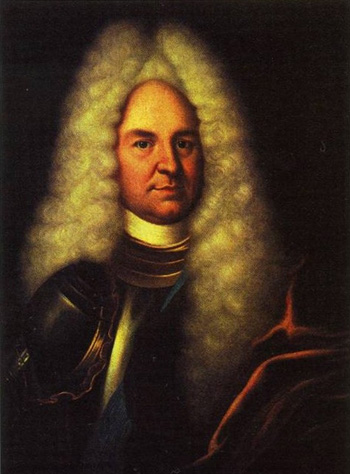
Patrick Leopold Gordon
Patrick Gordon fathered three sons and two daughters. Of the
lads, the eldest succeeded to the lands of Auchleuchries but the other two
followed their father’s path into the Russian army. His eldest daughter,
Katherine, married a German officer but was widowed in 1692 when her husband
lost his life in an accident with fireworks. In 1700 she married again, this
time to a kinsman of her father, Alexander Gordon. The latter came to Russia in
1696 after a spell in the French army, no doubt enticed by the success and
status of Patrick, and stayed on to rise to the rank of major-general.
After securing his position on the throne of Russia, Peter
the Great embarked on a drive to make his backward nation a powerful and
significant force in Europe. At the start of his reign Russia’s only direct
access to the open sea was through the cold, distant port of Archangel, and the
temptation for Peter was to establish outlets on the Black Sea and the Baltic.
It was an ambition, however, that brought him into conflict with the Ottoman
Empire and Sweden. In 1697 Karl XII had succeeded to the throne of the Vasas
and almost at once had to contend with troublesome neighbours: as well as
Russia, Poland and Denmark were itching to recover lost territories. In 1698,
all three formed an alliance to combat Sweden. Karl got his blow in first,
capturing Copenhagen in 1700 and forcing a surrender on Denmark, before
switching his attention to the east, defeating the Russians at Narva and Riga,
and occupying Courland. In 1701 the Swedes moved into Poland and then on into
Saxony. Karl, however, was stretching his resources dangerously thin, and it
could only be a matter of time before he would meet a reverse. It came at the
siege of the fortress of Poltava in Ukraine in July 1710: in the battle the
Swedes lost almost 16,000 men as casualties or prisoners and, although Karl
himself escaped with a handful of followers, it marked the end of Sweden’s
dominance of the Baltic. Among the prisoners taken by the Swedes at Narva was
Alexander Gordon. Back in Russian service, he defeated his former captors at
Kysmark and went on to defeat the Poles at Podkamian. He died at Auchintoul in
1751.
The Gordons – Patrick and Alexander – stand out as examples of Scots in the service of Peter the Great, but there were several more of their kinsmen and their countrymen in prominent military positions. For example, take George Ogilvy. A grandson of James Ogilvy of Airlie and son of an Ogilvy who became governor of Spielberg in Moravia, George was born in 1648 and rose to the rank of major-general in the service of the Habsburgs before Peter the Great spotted him in Vienna in 1698 and invited him to join the Russian army. His work in training and modernising Peter’s forces brought him to the rank of field marshal. He later switched to the service of Poland and died in Danzig in October 1710. Then there were the brothers James and Robert Bruce, whose father, William, had been a colonel in Russian service. James followed an interest in the natural sciences, including chemistry, and Tsar Peter put him in command of artillery. He also apparently showed a talent for shady financial dealing but this did not prevent him playing an important role in the Peace of Nystadt in 1721 when Russia finally acquired Estonia, Livonia and the lands around the head of the Gulf of Finland from Sweden. James was rewarded with an estate, where he died in 1735; he was buried in the Simonoff Monastery in Moscow. His titles were inherited by his nephew Alexander, who also achieved the rank of major-general and fought against the Turks.
John Graham of Claverhouse, later Viscount Dundee
Among the many Scots who distinguished themselves under the
different flags of Europe it is worth noting a few who are remembered for
exploits on their home soil but who had their first taste of armed conflict
abroad. John Graham of Claverhouse, Bonnie Dundee himself, travelled to France
after he graduated from St Andrews in 1668 to be a volunteer in the service of
Louis XIV. He moved four years later to the Low Countries to a commission as a
cornet in one of the Prince of Orange’s troops of horse guards. His arrival
coincided with the outbreak of war between the Netherlands and France, when
William of Orange was able to form an alliance with, among others, the
Habsburgs. On 11 August 1674, a joint Spanish–Dutch force under William’s
command was attacked by a strong French army at Seneffe near Mons and forced
into retreat. During the desperate confusion, William might have been captured
when his horse foundered in a marsh had not John Graham dismounted to give his
commander his saddle, an act for which he was promoted to captain. Perhaps
Graham presumed too much on the prince’s good will for he was passed over when
he later applied for promotion to lieutenant-colonel of one of the Scots
regiments in Dutch service and was aggrieved enough to quit the Low Countries,
returning to Scotland at the end of 1676.